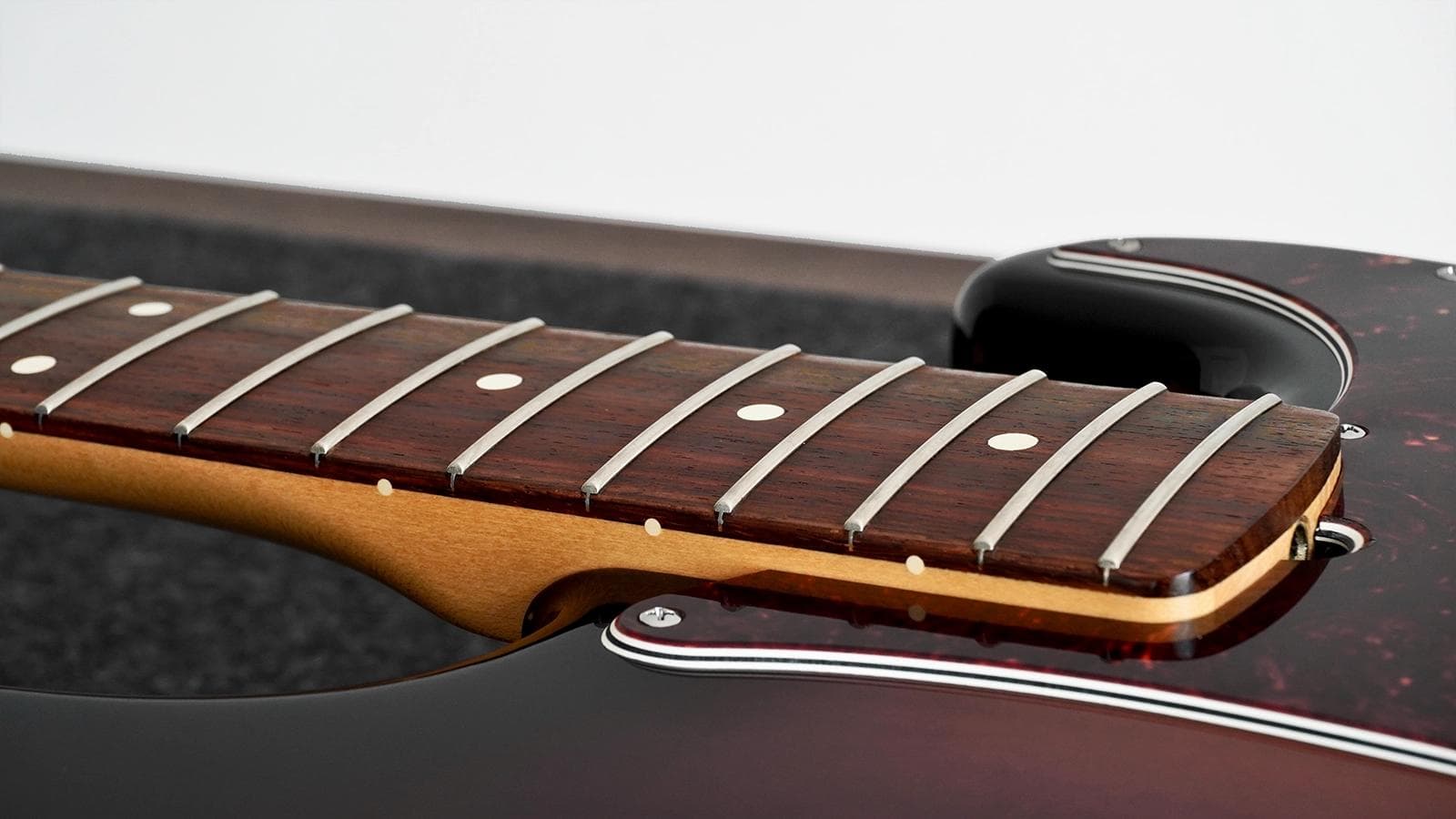Caring for Rosewood

Introduction
Rosewood requires a little bit of extra care and consideration to maintain it’s rich color and healthy moisture levels. This post goes over steps to clean, condition, protect, and maintain the rosewood on your instrument.
Cleaning
Before you condition a rosewood fretboard, it’s important to gently clean the surface to remove any built-up grime or debris. Rosewood is porous and unfinished, so it should always be cleaned with care.
- Wipe away loose debris
Use a clean, dry microfiber towel to remove dust and residue. Always wipe in the direction of the wood grain to avoid scratches.
- Spot clean with water only if needed
If the board has buildup or sticky spots, lightly dampen a corner of a microfiber towel with plain water, not alcohol or household cleaners. Gently rub the area, then immediately dry it with another towel.
- Don’t overdo it
Rosewood doesn't need regular deep cleaning. Cleaning too often can dry out or damage the wood.
- Clean before conditioning
Conditioning a dirty fretboard can lock in grime. Always give the wood a quick wipe-down during string changes before applying any oil or conditioner.
Conditioning
Once your rosewood fretboard is clean and dry, conditioning helps restore its natural oils and keep the wood from drying out or cracking. This process should be done sparingly, usually once or twice per year, sometimes less depending on climate.
- Choose the right oil
Use a conditioner made specifically for unfinished fretboards like rosewood. Avoid anything with silicone, wax, or harsh cleaners.
- Apply a small amount
Put a few drops of oil directly onto a clean microfiber towel or onto the fretboard itself. A little goes a long way, start with less than you think you need.
- Rub it in gently
Using a soft cloth, massage the oil into the wood in small circles or along the grain. Be sure to work it around the frets and into any visibly dry spots.
- Let it sit briefly
Allow the oil to absorb for 5–10 minutes. This gives the wood time to take in the moisture it needs.
- Wipe off the excess
Use a fresh cloth to remove any oil that hasn’t soaked in. The surface should feel smooth and dry, not oily or sticky.
- Let it settle before restringing
Wait a few minutes more after wiping down to let the fretboard fully absorb the conditioner before installing new strings.
Protecting
Even after cleaning and conditioning, rosewood needs protection from everyday environmental stress. Temperature, humidity, sunlight, and handling all play a role in keeping your fretboard healthy over time.
- Avoid direct sunlight
Prolonged exposure to UV light can dry out rosewood and fade its natural color. Store your guitar in its case or on a stand away from windows and bright light when not in use.
- Keep it in a stable environment
Wood is sensitive to changes in temperature and humidity. Ideally, store your guitar where the humidity stays between 40% and 60%. If your space is too dry, use a case humidifier to prevent the wood from shrinking or cracking.
- Use a high-quality fretboard oil
I recommend an oil that’s made from 100% natural seed and tree oils, free of lemon oil, petroleum, wax, silicone, and water. One that dries quickly, doesn’t leave behind any sticky residue, and works safely on rosewood, ebony, and unfinished maple. A good oil like this will clean, condition, and protect the fretboard without damaging it or altering its natural feel.
- Keep it clean between sessions
Wipe down the fretboard after playing to remove sweat and oils that can wear away the surface over time. Clean hands mean less grime and longer intervals between full cleanings.
- Don’t overtreat
Conditioning too much can cause build up and attract dust. Let your fretboard breathe between treatments and only reapply oil when the wood looks dry or faded.
Maintaining
Regular maintenance is the key to keeping your rosewood fretboard in good shape year after year. With just a little attention during string changes and everyday use, you can prevent buildup, dryness, and wear.
- Wipe it down regularly
Use a dry microfiber cloth to wipe off sweat, oils, and dust after every playing session. This small habit slows down grime buildup and keeps the wood feeling smooth.
- Clean during every string change
Every time you change your strings, take a few minutes to inspect and clean the fretboard. Even if it doesn’t need oil, a quick wipe keeps the surface fresh and prevents long-term damage.
- Watch for signs of dryness
Check for dullness, light cracking, or a rough texture. These are signs that your fretboard may need a light application of oil.
- Keep frets polished
Tarnished or dirty frets can catch your strings and collect grime. During string changes, polish the frets gently using a fretboard-safe metal polish and masking tape to protect the wood.
- Avoid over-conditioning
Condition only when necessary, usually once or twice a year. Too much oil can create buildup that traps dirt and dulls the feel of the fretboard.
- Store the guitar smartly
Between uses, keep your guitar in a stable environment. A case, even a soft one, offers protection from humidity swings, UV light, and dust.

Andrew D
March 1, 2025